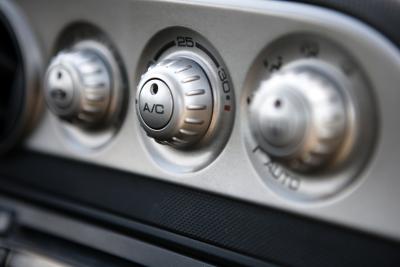
The air conditioning system on your vehicle is made up of several components. Each component plays a role in creating cold air. The air conditioning service fittings are pressure valves that allow you to troubleshoot and maintain the AC system. To recharge or pressure test your AC system, you need to use the service fittings. Your AC system has two service fittings --- a low-pressure fitting and a high-pressure fitting. Knowing the difference between the two service fittings can make maintaining your AC system easier.
The low-pressure service fitting and the high-pressure service fitting both have similar functions; however, the fittings are different in how they are used. The service fittings are used to pump new refrigerant into the air conditioning system. High-pressure recharge kits use the high-pressure fitting; low-pressure recharge kits use the low-pressure fitting. Both fittings are used together to troubleshoot the refrigerant pressure of the AC system. Manifold gauges are attached to both fittings to ensure the recommended pressure range of the AC system.
Though both service fittings look similar, they are not identical in size. The low-pressure fitting is a seven-sixteenths-inch threaded valve. The high-pressure fitting is a three-eights-inch threaded valve. The low-pressure fitting is slightly larger than the high-pressure fitting. The size difference is often used to distinguish the two fittings when mechanics are repairing the AC system. Low-pressure recharge kits will not connect to a high-pressure service valve.
The easiest way to distinguish a high-pressure fitting from a low-pressure fitting is by the location. The low-pressure fitting is attached to the refrigerant hose that runs from the accumulator to the compressor. The high-pressure fitting is attached to the refrigerant hose that goes from the compressor to the condenser.
The recommended pressure range for an R-12 low-side fitting is between 25 and 40 psi. An irregular pressure reading from the low-side fitting is an indication that something is wrong with the accumulator or evaporator. The recommended pressure range for a high-side fitting is between 200 and 225 psi. An irregular pressure reading from the high-side fitting is an indication that something is wrong with the condenser or receiver dryer.